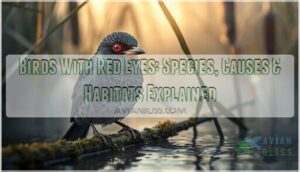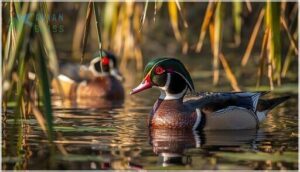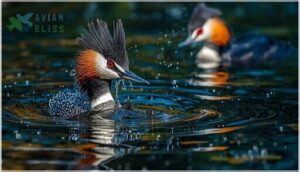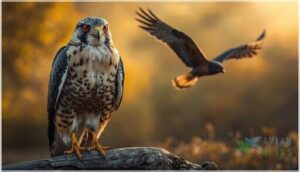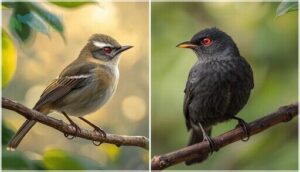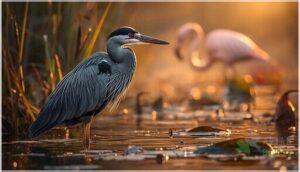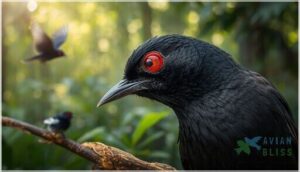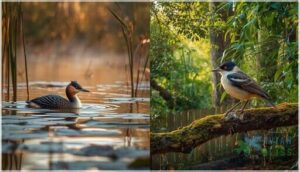This site is supported by our readers. We may earn a commission, at no cost to you, if you purchase through links.
You spot a bird perched on a branch, and its eyes lock onto yours—glowing crimson, like tiny embers set in feathers. That flash of red isn’t just striking, it’s a window into the bird’s biology, revealing secrets about diet, genetics, and even hunting prowess.
Birds with red eyes range from sleek raptors to wetland waders, each carrying this vivid trait for different reasons. Carotenoids from berries and crustaceans fuel the fiery hue in some species, while others display red simply because blood vessels show through translucent tissue.
These scarlet-eyed creatures inhabit marshes, woodlands, and city parks, adapting to environments where their unusual coloration functions as camouflage, communication, or a tool for sharper vision beneath the water’s surface.
Table Of Contents
Key Takeaways
- Red eyes in birds stem from three main biological sources: carotenoids from diet creating vivid hues, melanin controlling color intensity, and blood vessels showing through translucent iris tissue.
- Species with red eyes span diverse families including waterfowl like Wood Ducks, raptors such as Cooper’s Hawks, songbirds like Red-eyed Vireos, and waders including Black-crowned Night-Herons, each using this trait for different survival advantages.
- These crimson eyes serve practical functions beyond aesthetics—they enhance underwater vision for diving species, signal maturity and breeding readiness in raptors, and improve contrast sensitivity for hunting beneath the water’s surface.
- Red-eyed birds face significant conservation threats from habitat fragmentation, building collisions, and climate shifts, yet they play crucial ecological roles controlling insect populations and generating over $107 billion annually in birdwatching tourism.
What Causes Red Eyes in Birds?
When you spot a bird with piercing red eyes, you’re seeing nature’s palette at work in fascinating ways. The red coloration doesn’t happen by accident—it’s the result of specific biological factors that differ from species to species.
Let’s explore the three main causes behind those striking ruby eyes.
Role of Carotenoids and Melanin
When you spot a bird with red eyes, you’re seeing pigmentation at work. Carotenoids from their diet create those vivid red hues, while melanin controls how dark or light the color appears.
The interaction between these pigments produces everything from bright crimson to deep ruby tones. Think of it as nature’s color mixing—carotenoid metabolism generates the red, melanin synthesis fine-tunes the intensity, and together they create each species’ unique eye coloration.
These pigments also play a role in sexual attraction for many bird species.
Genetic and Environmental Influences
Beyond pigment chemistry, red eyes emerge from a fascinating gene-environment interaction. Genetic factors in birds—particularly pigment gene mutations in pathways like SLC2A11B—lay the foundation for eye coloration, but dietary carotenoids you see them consuming actually fuel the red intensity. Recent studies show that a single enzyme can drastically alter bird coloration.
Here’s what shapes these striking eyes:
- UV radiation effects trigger pigment alterations in sunlight-exposed species
- Epigenetic modifications respond to environmental stressors
- Melanin production genes regulate darkness versus brightness
- Eye pigments in birds vary based on habitat light quality
- Gene expression changes with carotenoid availability in their diet
Blood Vessel Visibility and Eye Pigments
While genetics and diet set the stage, you’ll find that blood vessel visibility actually creates those vivid red eyes. Vessel size and pigment concentration work together—enlarged blood vessels overlay iris pigments, intensifying the red coloration. Light reflection from purine layers beneath amplifies this effect.
In Wood Ducks, for example, anterior iris blood vessels produce their signature crimson gaze, with eye coloration intensity shifting based on blood flow and environmental lighting.
Common Bird Species With Red Eyes
You’ll find red eyes in birds from all walks of life, from ducks paddling through marshes to hawks soaring overhead. These species span different families and habitats, but they all share that distinctive crimson gaze.
Let’s look at some of the most notable groups where you’re likely to spot this striking feature.
Ducks and Waterfowl (Wood Duck, Cinnamon Teal)
When you look at male Wood Ducks, you’ll notice their bright red eyes working like nature’s spotlights against stunning plumage. Red eyes in waterfowl may improve underwater vision and play key roles in mate selection and duckling development. Here’s what you should know about these aquatic beauties:
- Cinnamon Teal males display vivid red eyes that contrast beautifully with their rusty bodies and red bills
- Wood Ducks showcase eye-plumage correlation, with males featuring more intense red than females
- American Coots use their red eyes for territorial signals, though hybridization risks remain minimal among waterfowl species
Grebes (Great Crested Grebe, Horned Grebe)
Among aquatic bird species with red eyes, grebes stand out for their striking underwater vision adaptations. Great Crested Grebes use their red eyes to improve contrast sensitivity while diving for fish, making them efficient hunters beneath the surface.
Horned Grebes, along with Eared and Western Grebes, showcase vivid red eyes that aid in grebe species ID and may play roles in grebe mating displays, though their eye coloration changes with age as they mature.
Raptors (Cooper’s Hawk, Black-winged Kite)
When you study raptors with red eyes, you’ll notice Cooper’s Hawks, whose eye development shifts from yellow in juveniles to striking red in adults. This eye color change functions as a social signal marking maturity.
Black-winged Kites, along with Sharp-shinned Hawks, display vivid red eyes that improve raptor vision for hunting strategies, helping these bird species track prey with great precision.
Songbirds (Red-eyed Vireo, Fire-eyed Diucon)
You’ll recognize the Red-eyed Vireo by its vivid red eyes, especially noticeable during breeding season. This bird species with red eyes breeds across the U.S. and Canada, then embarks on Vireo migration to South America.
Fire-eyed Diucons inhabit South American Diucon habitats, their bright red eyes contrasting dramatically with dark plumage. Eye color in birds often intensifies with age and health.
Songbird vision benefits from these eye pigments, while vocalizations help these songbirds communicate.
Herons and Waders (Black-crowned Night Heron, American Flamingo)
Black-crowned Night-herons develop striking red eyes as adults, while juveniles sport yellowish eyes until maturation—a marker of Juvenile Development and sexual readiness.
You’ll find these herons in bird habitats ranging from wetlands to urban ponds, showcasing impressive Habitat Adaptation.
Their Social Behavior includes dense colony nesting, and Diet Variation spans fish to crustaceans, making them resilient bird species despite shifting Conservation Status pressures.
Physical and Behavioral Traits of Red-Eyed Birds
Red-eyed birds aren’t just striking to look at—they carry a whole package of unique traits that set them apart from their feathered cousins. From the shades and patterns in their eyes to how they hunt, mate, and move through their worlds, these birds show fascinating variety.
Let’s explore the physical features and behaviors that make red-eyed species so distinctive.
Eye Coloration Patterns and Intensity
You’ll notice that red eye coloration isn’t uniform across species—it’s a spectrum. Pigment distribution and carotenoid pigments create color variation from pale orange to deep crimson, with some birds showing measurable UV reflectance that enhances intensity.
Age influence matters too, as older birds often develop darker eyes. Regional differences and the functions of red eyes vary, with pigmentation patterns reflecting both genetics and environment in these fascinating characteristics of red eyes.
Distinctive Plumage and Body Shapes
When you look at red-eyed birds, you’ll find their physical characteristics reveal striking contrasts. Bird plumage and body structure show clear habitat adaptation across avian characteristics:
- Red-eyed Vireos display stocky builds with olive-green backs and white bellies, measuring just 12–13 cm
- Horned Grebes feature compact, rounded bodies with black and rust plumage patterns suited for diving
- Cooper’s Hawks combine agile raptor frames with barred grey-brown feathers, where eye-plumage correlation aids species recognition
Mating Displays and Communication
Beyond physical traits, red eyes play an important role in courtship displays and breeding behaviors of birds. Visual signaling through red eye intensity helps you spot attracting mates rituals, like Western Grebes’ synchronized water dances.
Avian communication combines auditory integration—think red-eyed vireos’ persistent songs—with aggressive displays and hormonal correlates that signal breeding readiness. This evolutionary significance extends from mate selection to territorial defense, where red eyes improve intimidation and honest signaling.
Feeding and Foraging Behaviors
Red eyes aren’t just for show—they help birds spot food with precision. You’ll notice their feeding habits shift dramatically with seasons and habitat, reflecting diverse energy needs.
Here’s how red-eyed birds forage:
- Insectivorous diet dominates summer: Red-eyed vireos glean caterpillars and beetles from leaves, with insects comprising 50% of their warm-season intake.
- Fruit consumption peaks during migration: Fall brings a shift to elderberries and dogwood, fueling long flights.
- Foraging techniques vary by species: Wood ducks dabble in shallows while vireos methodically work through canopies.
- Seasonal influences drive behavior: Winter scarcity pushes birds toward agricultural grains and urban parks.
- Energy needs shape bird diet and foraging: Protein-rich aquatic insects support breeding, while fat reserves from fruit power migration.
These bird behavior patterns reveal striking adaptability across different habitat types.
Habitats and Geographic Distribution
Red-eyed birds don’t just stick to one type of landscape—you’ll find them everywhere from marshy wetlands to dense forests, and even in your own backyard. Where these birds live often depends on what they eat, how they nest, and whether they migrate with the seasons.
Let’s look at the specific habitats where you’re most likely to spot these striking species.
Wetlands and Aquatic Environments
Across marshes, ponds, and aquatic environments, you’ll spot red-eyed water birds like American coots and grebes thriving in their natural habitat. These species rely on wetland distribution patterns, where their aquatic behavior helps them hunt fish and insects.
However, habitat degradation and conservation threats, including pollution and wetland loss, put their populations at risk. Their ecological importance as wetland health indicators makes protecting bird habitats and distribution essential.
Forests and Woodlands
Shifting to forested areas, you’ll discover the Red-eyed Vireo thriving in deciduous woodlands across Eastern North America. These Forest Vireo inhabitants demonstrate fascinating red-eye behavior through persistent territorial singing—sometimes reaching 20,000 calls daily.
Forest Distribution patterns reveal:
- Preference for dense canopy cover with mature trees
- Nesting in interior woodland habitats rather than edges
- Foraging by gleaning insects from leaf undersides
- Seasonal presence from mid-April through October
Forest Conservation efforts protect these insectivorous bird species.
Global Distribution Patterns
When you examine Continental Range patterns, you’ll notice red-eyed birds span multiple Biogeographic Zones. The Red-eyed Vireo exemplifies this, breeding across Canada and North America before following Migratory Routes to South America’s Amazon Basin.
Latitudinal Variation shapes where species settle—waterfowl like Redheads occupy wetlands from northern Canada to the Caribbean, while raptors demonstrate Habitat Specificity tied to temperate forests and aquatic environments supporting their prey.
Adaptation to Urban and Rural Areas
While urban environments challenge red-eyed bird species, many adapt remarkably. Light pollution drives genetic markers for smaller eyes in resident populations, and habitat fragmentation pushes birds to exploit patchy green spaces.
Cooper’s Hawks time hunts with traffic signals, showcasing sophisticated bird behavior in cities. Urban nesting incorporates human materials, whereas rural habitats maintain traditional foraging strategies.
These adaptations reveal how diverse bird habitats shape survival across landscapes.
Conservation and Ecological Importance
Red-eyed birds aren’t just fascinating to look at—they’re also key players in their ecosystems, and many face real threats in the wild. From habitat loss to shifting climates, these species need our attention if they’re going to stick around.
Let’s explore what puts them at risk, why they matter so much to nature, and what’s being done to protect them.
Threats to Red-Eyed Bird Populations
You might be surprised to learn that habitat fragmentation ranks as the most severe threat facing these striking birds. Building collisions and nest parasitism from cowbirds add significant pressure, while chemical contaminants reduce essential insect prey.
Climate impacts shift suitable ranges, and predators exploit fragmented ecosystems more easily.
Conservation of bird species requires protecting connected habitats and addressing these interconnected challenges to help nature conservation succeed.
Ecological Roles and Adaptations
These birds keep ecosystems running smoothly through powerful adaptations. You’ll find them controlling insect populations like aphids and caterpillars, while their striking visual signaling helps attract mates and claim territory.
Host-parasite interactions shape their breeding success, and their habitat choices engineer healthier environments.
Genetic adaptations enable red pigmentation that enhances vision and predator detection, making them key ecosystem players despite camouflage challenges.
Significance in Birdwatching and Culture
When you spot a red-eyed bird, you’re joining a global community driving over $107 billion in birding tourism annually.
Spotting a red-eyed bird connects you to a global birding community that drives over $107 billion in tourism annually
These species serve as flagship icons in bird identification guides, sharpening your bird species recognition skills while connecting you to deep cultural symbolism and folklore omens across traditions.
Their economic impact funds conservation messaging, transforming birdwatching into powerful environmental stewardship that protects habitats worldwide.
Ongoing Research and Conservation Efforts
Tracking declining populations starts with programs like the Breeding Bird Survey, which monitors red-eyed species across hundreds of routes to guide targeted conservation.
You’ll find habitat restoration efforts making real progress:
- Monitoring Programs track population trends through long-term surveillance initiatives
- Habitat Restoration projects rehabilitate degraded ecosystems for forest-dwelling species
- Climate Adaptation strategies integrate climate models using 140 million bird observations
- Funding Policies direct billions annually toward protecting threatened bird species distribution
- Community Actions engage citizen scientists in local habitat and environment stewardship
These coordinated efforts address migration patterns disruption and habitat loss across breeding ranges.
Frequently Asked Questions (FAQs)
What kind of bird has red eyes?
You’ll encounter red-eyed birds across diverse species variations—from diving ducks like Wood Ducks to songbirds such as Red-eyed Vireos.
Red-eye identification depends on habitat preferences, diet influence, and unique genetic traits that create striking crimson irises.
Why does my bird have red eyes?
Your bird’s red eyes may reflect natural breed variation in eye coloration, diet influence from carotenoids, or signal concern.
Sudden redness could indicate injury or infection, warranting veterinary assessment to rule out health issues.
What kind of bird is black with red eyes?
You might wonder if the glossy black Phainopepla truly has red eyes—it does.
Found in southwestern deserts, this sleek species displays striking crimson irises, contrasting beautifully with dark plumage and white wing patches.
How common is Red-eyed Vireo?
You’ll find Red-eyed Vireo populations thriving across North America, with an impressive 130 million breeding adults.
Their habitat adaptability and stable conservation status make them one of the continent’s most abundant songbirds.
What birds have red eyes?
You’ll encounter striking red-eyed birds across various families, from Wood Ducks and Cinnamon Teals to Cooper’s Hawks, Great Crested Grebes, and Red-eyed Vireos. Their distinctive crimson iris appearance is determined by eye color genetics.
What causes red eyes?
Red eyes in birds can result from pigment production involving carotenoids and melanin, genetic mutations affecting coloration, or visible blood vessels through translucent irises.
Additionally, oxidative stress or environmental irritants may cause inflammation in your bird’s delicate eye tissues.
Why do birds have red eyes?
You’ll notice red eyes in birds due to genetic factors controlling pigment composition, especially carotenoids and melanin. Vascular prominence also plays a role.
Environmental adaptation shapes visual signaling for communication and survival.
What bird has red eyes at a pond?
When you’re scanning a pond for wildlife, certain waterfowl stand out. Wood Ducks, American Coots, and grebes like the Eared Grebe display striking red eyes—essential for bird identification and understanding aquatic adaptations.
Are there any Red Birds?
You’ll encounter all-red species like cardinals and tanagers across various regions.
These birds with red eyes display stunning plumage variations and reddish hues, making bird identification easier when you’re spotting redeyed bird species.
Why do lovebirds have red eyes?
When you spot a lovebird’s striking crimson gaze, you’re witnessing genetic mutations at work. Melanin absence and carotenoid intake create this red-eyed trait, distinct from pathological causes—a fascinating example of avian vision evolution.
Conclusion
When you catch that flash of crimson in a bird’s gaze, you’re witnessing evolution’s brushwork—carotenoids coloring irises, blood vessels glowing through delicate tissue, genetics scripting hues across continents.
Birds with red eyes thrive in marshes, forests, and your backyard, each species carrying its scarlet signature for survival, courtship, or simply sharper sight.
Next time those ruby eyes meet yours, remember: you’re not just seeing a bird. You’re glimpsing the intricate tapestry of biology, habitat, and adaptation woven into every feathered encounter.
- https://birdweb.org/birdweb/bird/horned_grebe
- https://www.theguardian.com/environment/2025/jan/18/country-diary-why-does-the-bird-bob-its-head
- https://www.wikihow.com/Bird-Symbolism
- https://apnews.com/article/composting-pumpkins-halloween-jack-o-lanterns-gardening-921757fbb2bf84d9e5c55f55a63b280a
- https://www.audubon.org/field-guide/bird/coopers-hawk

